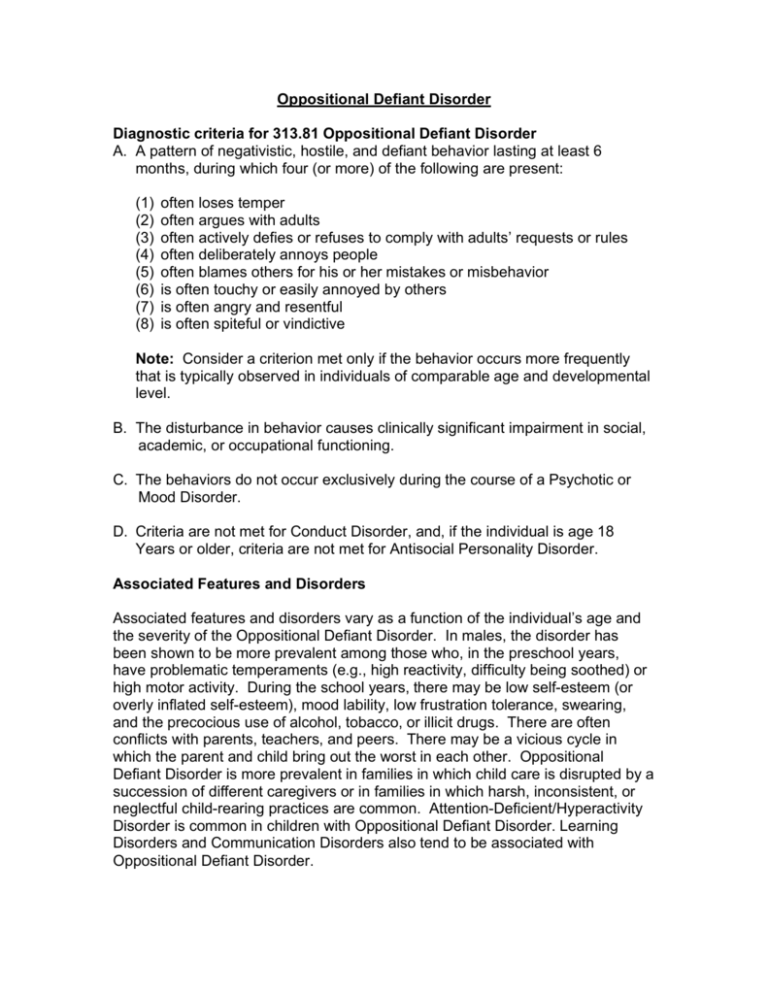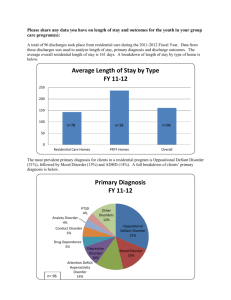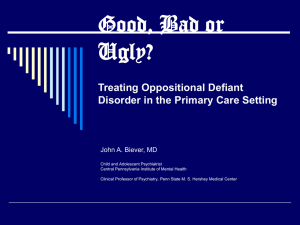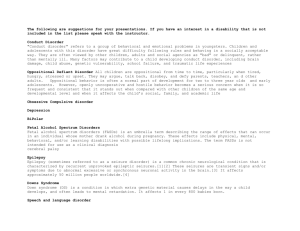Oppositional Defiant Disorder Diagnostic criteria for 313.81
advertisement

Oppositional Defiant Disorder Diagnostic criteria for 313.81 Oppositional Defiant Disorder A. A pattern of negativistic, hostile, and defiant behavior lasting at least 6 months, during which four (or more) of the following are present: (1) (2) (3) (4) (5) (6) (7) (8) often loses temper often argues with adults often actively defies or refuses to comply with adults’ requests or rules often deliberately annoys people often blames others for his or her mistakes or misbehavior is often touchy or easily annoyed by others is often angry and resentful is often spiteful or vindictive Note: Consider a criterion met only if the behavior occurs more frequently that is typically observed in individuals of comparable age and developmental level. B. The disturbance in behavior causes clinically significant impairment in social, academic, or occupational functioning. C. The behaviors do not occur exclusively during the course of a Psychotic or Mood Disorder. D. Criteria are not met for Conduct Disorder, and, if the individual is age 18 Years or older, criteria are not met for Antisocial Personality Disorder. Associated Features and Disorders Associated features and disorders vary as a function of the individual’s age and the severity of the Oppositional Defiant Disorder. In males, the disorder has been shown to be more prevalent among those who, in the preschool years, have problematic temperaments (e.g., high reactivity, difficulty being soothed) or high motor activity. During the school years, there may be low self-esteem (or overly inflated self-esteem), mood lability, low frustration tolerance, swearing, and the precocious use of alcohol, tobacco, or illicit drugs. There are often conflicts with parents, teachers, and peers. There may be a vicious cycle in which the parent and child bring out the worst in each other. Oppositional Defiant Disorder is more prevalent in families in which child care is disrupted by a succession of different caregivers or in families in which harsh, inconsistent, or neglectful child-rearing practices are common. Attention-Deficient/Hyperactivity Disorder is common in children with Oppositional Defiant Disorder. Learning Disorders and Communication Disorders also tend to be associated with Oppositional Defiant Disorder. Specific Age and Gender Features Because transient oppositional behavior is very common in preschool children and in adolescents, caution should be exercised in making the diagnosis of Oppositional Defiant Disorder especially during these developmental periods. The number of oppositional symptoms tends to increase with age. The disorder is more prevalent in males that in females before puberty, but the rates appear to be equal after puberty. Symptoms are generally similar in each gender, except that males may have more confrontational behavior and more persistent symptoms. Prevalence Rates of Oppositional Defiant Disorder from 2% to 16% have been reported, depending on the nature of the population sample and methods of ascertainment. Course Oppositional Defiant Disorder usually becomes evident before age 8 years and usually not later that early adolescence. The oppositional symptoms often emerge in home setting but over time may appear in other settings as well. Onset is typically gradual, usually occurring over the course of months or years. In a significant proportion of cases, Oppositional Defiant Disorder is a developmental antecedent to Conduct Disorder. Although Conduct Disorder, Childhood-Onset Type is often preceded by Oppositional Defiant Disorder, many children with Oppositional Defiant Disorder do not subsequently develop Conduct Disorder. Familial Pattern Oppositional Defiant Disorder appears to be more common in families in which at least one parent has a history of a Mood Disorder, Oppositional Defiant Disorder, Conduct Disorder, Attention-Deficit/Hyperactivity Disorder, Antisocial Personality Disorder, or a Substance-Related Disorder. In addition, some studies suggest that mothers with a Depressive Disorder are more likely to have children with oppositional behavior, but it is unclear to what extent maternal depression results from or causes oppositional behavior in children. Oppositional Defiant Disorder is more common in families in which there is serious marital discord. Differential Diagnosis The disruptive behaviors of individuals with Oppositional Defiant Disorder are of a less severe nature that those of individuals with Conduct Disorder and typically do not include aggression toward people or animals, destruction of property, or a pattern of theft of deceit. Because all of the features of Oppositional Defiant Disorder are usually present in Conduct Disorder, Oppositional Defiant Disorder is not diagnosed if the criteria are met for Conduct Disorder. Oppositional behavior is a common associated feature of Mood Disorders and Psychotic Disorders presenting in children and adolescents and should not be diagnosed separately if the symptoms occur exclusively during the course of a Mood or Psychotic Disorder. Oppositional behaviors must also be distinguished from the disruptive behavior resulting from inattention and impulsivity in AttentionDeficit/Hyperactivity Disorder. When the two disorders co-occur, both diagnoses should be made. In individuals with Mental Retardation, a diagnosis of Oppositional Defiant Disorder is given only if the oppositional behavior is markedly greater that is commonly observed among individuals of comparable age, gender, and severity of Mental Retardation. Oppositional Defiant Disorder must also be distinguished from a failure to follow directions that is the result of impaired language comprehension (e.g., hearing loss, Mixed ReceptiveExpressive Language Disorder). Oppositional behavior is a typical feature of certain developmental stages (e.g., early childhood and adolescence). A diagnosis of Oppositional Defiant Disorder should be considered only if the behaviors occur more frequently and have more serious consequences than is typically observed in other individuals of comparable developmental stage and lead to significant impairment in social, academic, or occupational functioning. New onset of oppositional behaviors in adolescence may be due to the process of normal individuation. Causes • • • • • • It may be related to the child’s temperament and the family’s response to that temperament. A predisposition to ODD is inherited in some families. There may be problems in the brain that cause ODD. It may be caused by a chemical imbalance in the brain. Problems to begin between ages 1-3. If a parent is alcoholic and has been in trouble with the law, their children are almost three times as likely to have ODD. 18% of children will have ODD if the parents are alcoholic and the father has been in trouble with the law. Symptoms • • • • • • • • Losing your temper Arguing with adults Defying adults or refusing adult requests or rules Deliberately annoying others Blaming others for your own mistakes or misbehavior Being touchy or easily annoyed Being angry and resentful Being spiteful or vindictive • • • • • • • • • Swearing or using obscene language Having a low opinion of yourself Moody and easily frustrated May abuse drugs Holding grudges for days on end Mean and hateful talking when upset Seeking revenge Stubbornness Testing limits *usually seen in multiple settings, but may be more noticeable at home or at school* Prognosis and Course of Conduct Disorder Perhaps about 30% of conduct disorder children continue with similar problems in adulthood. It is more common for males with CD to continue on into adulthood with these types of problems that females. Females with CD more often end up having mood and anxiety disorders as adults. Substance abuse if very high. About 50-70% of ten year olds with conduct disorder will be abusing substances four years later. Cigarette smoking is also very high. A recent study of girls with conduct disorder showed that they have much worse physical health. Girls with conduct disorder were almost 6 times more likely to abuse drugs or alcohol, eight times more likely to smoke cigarettes daily, where almost twice as likely to have sexually transmitted diseases, had twice the number of sexual partners, and were three times as likely to become pregnant when compared to girls without conduct disorder. Looked at from the other direction, by the time they are adults, 70% of children no longer show signs of Conduct disorder. Are they well? Some are, but what often happens is that the comorbid problems remain or get worse. That is a girl with CD and depression may end up as an adult with depression, but no conduct disorder. The same pattern can be true of CD plus bipolar disorder and other disorders. Here are some examples that illustrate this. ODD is a recurrent pattern of negativistic, defiant, disobedient, and hostile behavior toward authority figures that persists for at least 6 months. Who Gets It • • • The most common psychiatric problem in children- a lot of children get it Over 5% of children have this It is more common in younger boys that girls, but as they grow older, the rate is the same in males and females. What Will Happen When They Grow Up • • • • • • There will be some lucky children who outgrow this. About half of children who have ODD as preschoolers will have no psychiatric problems at all by age 8. ODD may turn into something else. About 5-10% of preschoolers with ODD will eventually end up with ADHD and no signs of ODD at all. Other times ODD turns into conduct disorder (CD). This usually happens fairly early. That is, after a 3-4 years of ODD, if it hasn’t turned into CD, it won’t ever. What predicts a child with ODD getting CD? A history of biologic parent who was a career criminal, and very severe ODD. The child may continue to have ODD without anything else. However, by the time preschoolers with ODD are 8 years old, only 5% have ODD and nothing else. They continue to have ODD but add on comorbid Depressive Disorders. BY the time these children are in the end of elementary school, about 25% will have mood or anxiety problems which are disabling. That means that it is very important to watch of signs of mood disorder and anxiety as children with ODD grow older. They will probably not end up as criminals unless they develop conduct disorder. Even then many will grow out of it. Life may not be easy. People with ODD who are grown up often do best of they can work for themselves and stay away from alcohol. However their tendency to irritate others often leads to a lonely life. Later in life, it can develop into Passive Aggressive Personality Disorder or Antisocial Personality Disorder. With treatment, reasonable social and occupational adjustment can be made in adulthood. Accommodations for Students with ODD • • • • • • • • • • • • • • • • Arrange the seating to minimize distraction and benefit the students Use positive reinforcement as a discipline tool Change reinforcers often to create interest Avoid power struggles Set clear expectations Always give students choices Teach students muscle relaxation techniques Teach moral reasoning and problem-solving skills Model effective communication skills Use a token economy or other behavior modification program Use cooperative learning Incorporate students’ interests into lessons Question student about misbehavior rather that make declarations Remain calm and do not show anger when misbehavior occurs Focus on the child Have a plan of what you will do when misbehavior occurs It is important to note that a counselor or therapist will consider a diagnosis of oppositional defiant disorder only if the behavior occurs more frequently that is typically observed in individuals of comparable age and developmental level. In other words, the problems and conflicts between teens and parents are as old as time itself, and some conflict is normal and inevitable. However, when the parent/child conflict becomes increasingly severe and appears to be spiraling out of control, then ODD might be considered. Also, as teens are growing and learning, they will sometimes do some very ill-advised things that con cause them problems, both legal and in school. However, if this behavior does not repeat itself and is a one-time event, then a behavior disorder is probably not present. For a diagnosis of ODD to be made, the disturbance in behavior must be causing significant problems in school, in relationships with family and friends, and in the workplace. ODD will not be diagnosed if the therapist suspects that the teen’s behaviors are being directly caused by another psychotic or mood disorder, such as bipolar disorder. Kids with oppositional defiant disorder will show some of the same behaviors as those listed above for conduct disorder, including being very negative, angry and defiant. However, with ODD, one does not generally see the mean or cruel behavior that is present in conduct disorder, such as cruelty to animals. All children are oppositional from time to time, particularly when tired, hungry, stressed or upset. They may argue, talk back, disobey, and defy parents, teachers, and other adults. Oppositional behavior is often a normal part of development for two to three year olds and early adolescents. However, openly uncooperative and hostile behavior becomes a serious concern when it is so frequent and consistent that it stands out when compared with other children of the same age and developmental level and when it affects the child’s social, family, and academic life.



